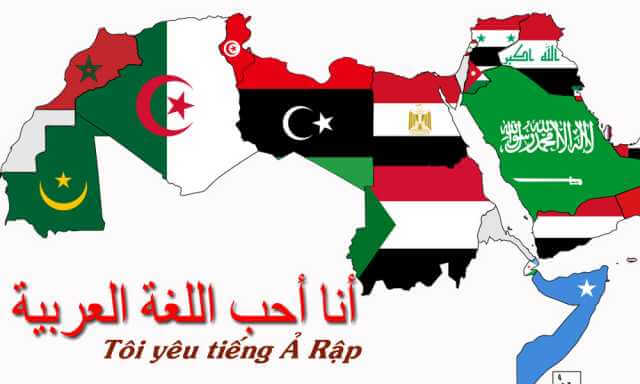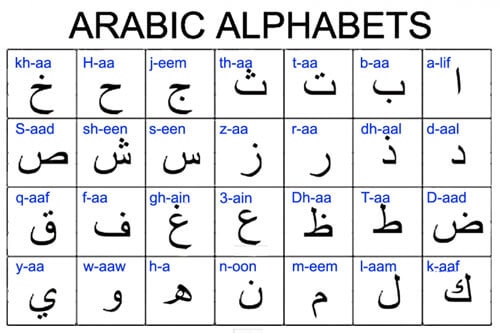Some languages have a few characteristics in common, but Arabic and English have major differences. Due to the development of each language, even languages belonging to the same language family or branch can have some differences. Therefore, English and Arabic, which come from different language families, will have many differences.
Family Different Languages
English comes from the Indo-European language family, which is divided into three main branches: East Germanic, North Germanic, and West Germanic. English belongs to the West Germanic language branch, which is divided into Anglican languages of the North Sea Germanic group.
Arabic comes from the Semitic group of languages from the Afroasiatic family of languages from the Middle East. Among the Semitic languages, the most spoken are Arabic, Amharic, Tigrinya, Hebrew, Tigre, Aramaic and Maltese.
English is the third most spoken language in the world, the first language spoken by 379 million people in 137 countries. On the other hand, Arabic is spoken in 59 countries. The fifth most spoken language in the world, it is the first language of 319 million people.
Note: Cheap, Prestigious, Professional Italian Translation Price List
Arabic Writing
Arabic has eight diphthongs/vowels and 28 consonants. Short vowels are not very important in Arabic and are usually not written. For example, maktab (office) is written as mktb, omitting vowels, like shorthand. This is very difficult for English speakers trying to learn Arabic because they have to deduce which vowel to use based on other Arabic letters. Arabic texts are written and read from right to left, using a cursive script, compared to English written in Latin and read from left to right. In Arabic, there is no distinction between lowercase and uppercase letters and the rules for using punctuation are looser than in English.
Vowels And Consonants
English has only five vowels (or six, if the letter y is included). Arabic usually has six vowels and two occasional vowels. But these vowels have distinct tones.
Arabic has six distinct phonemes that cannot be found in the English language. That is one of the reasons why translating Arabic to English is difficult. It is difficult for English speakers to pronounce Arabic because of the different ways. Arabic speakers will contract their epiglottis as they speak, something English speakers are not used to.
The sounds of letters in a language are different from the sounds of speech they can produce. m taste is the sound of speech. The English alphabet has 20 consonants producing 24 consonant phonemes of which six vowels (including y) can produce 22 vowel phonemes, while Arabic has only eight vowel phonemes and 28 consonant phonemes.
Although Arabic uses consonants heavily, English uses many consonant clusters (groups of phonemes) when forming words. Some Arabic words use two consonant clusters at the beginning of words but never three consonant clusters. Arabic also does not have three or four consonant clusters at the end of words, unlike English.
The three main vowel sounds in Arabic are similar to the I, A and U sounds in English. They are both long and short. But Arabic has no vowel sounds for the letters E and O. For example, the English pronunciation of Cairo becomes Kahirah in Arabic. m of o and e are only used in brand names and foreign loanwords.
Note: Cheap, Prestigious Professional French Translation Prices
Tense
Various and irregular verb tenses in English are absent in Arabic. The language has no present tense conjugation of the verb to be. Likewise, Arabic does not have a present perfect conjugation.
Stress
In Arabic, there is usually an accent. Changes occur frequently in English, as stress can change the vocabulary category and the meaning of the word. For example, object is a noun while object is a verb. However, a change in accent does not change the meaning in Arabic. The difference can only be noticed through the pronunciation of the word using a different short vowel. However, that is not very clear to English speakers, since the word is spelled the same way.
Sound Swallow
Swallowing means removing sounds between words or in the middle of a word when saying a certain sentence. Swallowing sounds are common in English, so you often hear dunno (I don't know), wanna (I want to), kamra (camera), or cap'n (captain). Swallowing sounds are not usually present in Arabic because the spelling of words is very closely related to the sounds the letters make, so as a rule any letter sound should not be ignored. .
Grammar
Arabic distinguishes between genders in the structure of sentences, words, verbs, and pronouns. This language even has standards for you and in singular, plural, male and female forms. The way verbs are conjugated in Arabic is different. All verbs come from the stem, with the conjugation starting in the past tense of the verb. They are conjugated by sex and number. Although complex, Arabic grammar structure is systematic. It doesn't have a bunch of exceptions. Arabic words are written the way they are expressed orally.
Note: Cheap Prestige Professional Portuguese Translation Price List
Original
Since Arabic is made up of consonants, the root word contains no vowels. Root consonant is another term used for this occurrence. To form words, vowels mixed between a series of consonants are added. The change in meaning of words depends on the use of vowels. So it's normal to see Arabic words beginning with consonants. English words, on the other hand, are formed by syllables with a combination of vowels and consonants. Furthermore, English words can begin with a consonant or vowel.
But did you know that despite being composed of consonants, Arabic has phrases with fewer consonants than English?
Here are some examples of consonant clusters in English:
- Splash
- Twelfths
- sixth
- twisty
- Crisp
- Scribble
- Spry
Quality and Length of Vowels
Another significant difference between English and Arabic is in the quality and length of vowels. Arabic often uses diphthongs and long vowels to form the numerator, considering short vowels to be insignificant in word formation. There are only three short vowels present in Arabic and they are homophones, which means they are used in some variation or used interchangeably.
Short vowels are not fully represented in their writing system. Usually, representations of short vowels are made through the use of diacritics.
In English, short and long vowels are equally important in word formation because they contribute to the difference in word meanings.
Note: Prestigious, Cheap, Professional Swedish Translation Price List
Structure of sentences
The basic sentence structure of English and Arabic is also different. English has only sentences according to words. Arabic has sentences according to words and nouns. Arabic noun phrases do not require a verb and usually consist of only two nouns. A complete and grammatically correct English sentence contains a subject, verb, and object.
Arabic has four different types of sentences: verbal, functional, noun and non-functional. Verbal sentences and noun sentences are the most common. In a noun sentence, you need a subject and an interpretation (object), no verbs are needed. Noun sentences describe an event or a person. Another sentence is a verbal sentence, which in Arabic has a verb, subject and object or interpretation. Both these types of sentences in Arabic also have different variations.
Because of the many differences between Arabic and English, it is difficult for Arabic and English learners to understand the intricacies of the individual languages. In Arabic, the sound of letters depends on the mood of the sentence and students should memorize the pronunciation of consonants sun letter and moon letter.
Furthermore, Arabic also has some variations or jargon. However, if you are learning Arabic, you should know that Modern Standard Arabic is the version taught today, understood by Arabic speakers all over the world. It is the language used in social media and print, in written materials, lectures, TV shows, etc.
Note: Cheap, Prestigious, Professional Japanese Translation Price List
Professional Arabic Translation Service
Arabic is a difficult and complex language, so if you ask Arabic translation service, you should work with a professional translation company. Arabic translation requires an experienced and native-speaking translator, and Idichthuat can help you with that. Our translators handle more than 100 languages including Arabic, all with expertise in specialized fields at home and abroad. With sharing about Arabic, Idichthuat Hope you gain useful knowledge and choose for yourself a professional - accurate - fast Arabic translation company in Vietnam today.
Contact us today for the fastest service quote and consultation.
| ✔️ See more related information: | 👉 Reliable, Cheap, Professional Swedish Translation Chuyên |
| 👉 The Most Professional Electronic Translation | |
| 👉 Quick Translation of Seafood Documents | |

Nguyen Trung Khang - Talented interpreter and translator, passionate about translation
Nguyen Trung Khang is a talented interpreter and translator, with many years of experience in the field of translation and linguistics. He graduated from Ho Chi Minh City University of Education, majoring in Linguistics in 2015.
After graduating, Mr. Khang participated in a professional interpretation and interpretation training course at the University of Foreign Languages - Hanoi National University. He achieved a high-level certificate in interpreting and interpreting, and was also awarded a master's degree in linguistics.




